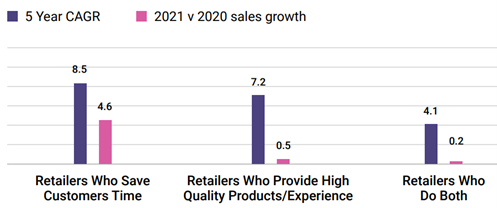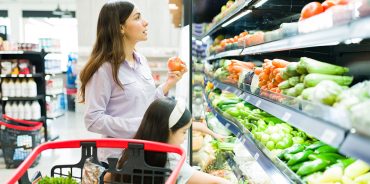The ‘Blah Blah Blah’ Shopper
The ‘Blah Blah Blah’ Shopper
The role of technology in grocery retail is increasingly pervasive: self-checkout tills, ’just walk out‘ stores1 and an augmented reality app to help customers find a product2. dunnhumby’s US Retailer Preference Index (RPI)3,4 shows the customer’s need for speed is an essential part of being a successful retailer (as are other variables like value).

Figure 1: dunnhumby’s US Retail Preference Index (RPI)3 shows how retailers who save customers time are more likely to grow when compared to retailers who focus on quality products/experience.
So, are there more attributes for a positive store experience?
In markets such as the UK (RPI 2021), the data suggests a closer link between speed and ’friendly staff‘. This may imply staff are an important part of speeding up the shopping trip for example, in finding a product. Furthermore, when reviewing 11 other RPI studies across Asia, Europe and Latin America, ‘store experience‘ (including both speed and staff) was consistently one of the top pillars for a successful retailer.
However, in Europe there is a small development which reminds retail that customers are born to be social. The Dutch retailer Jumbo have introduced ‘chat registers‘ for the less busy customer who would like to have a chat5. The French retailer Carrefour has likewise introduced ‘blablabla’ tills, with other retailers like Hyper U and Auchan to follow6.

Figure 2: shows the “blah blah blah” till in Carrefour, France6.
This need for speed on one hand and need for conversation on the other highlights a dichotomy for retail. It also highlights a far deeper and longer running problem of loneliness, which has increased despite decade-old pleas for more informal public gathering places7. Loneliness is a silent killer, correlated with a 26% increase in premature mortality and it affects 1 in 3 people in industrialised countries8. Globally, 2 in 5 office workers are lonely9, and it’s not just limited to older people – loneliness can affect young people too10. The problem has become so stark that the WHO declared it a major health concern in 2019 and the UK had the world’s first minister for loneliness in 201811. Some conclude we are living in ’The Lonely Century’12.
There have been warning signs before with regards to automation and loneliness in the past. In 2017, a UK survey found 24% of older people were deterred from shopping at automated checkouts13. Further back in 2015 the UK supermarket Morrisons found 96% of customers preferred staffed checkouts so they had someone to chat to14. Whilst these past findings demonstrate how customer sentiment may change, it also acts as a warning sign for things that can come back to haunt you.
So what can retailers do to bridge the gap between speed and the social touch? What follows are just a few starter ideas:
- The blah blah blah till concept can easily be applied to online when receiving products (perhaps as a premium delivery/collection service).
- Deploy staff in particular categories where advice may be needed (e.g., makeup).
- Develop voice-activated AIs (VAIs) systems to order groceries (e.g. Alexa). There is evidence customers anthropomorphasise their VAI leading to satisfaction and repurchase intention15.
- Use more social cues on websites and apps (e.g., interactive tour guides) to increase the perception of human connection16.
- Provide opportunities for customers to socialise with each other (e.g., café’s, cooking classes).
- Permit areas for in-store activities (e.g. table tennis); engaging activities (as opposed to passive activities) led to greater spend in shopping malls17.
- In the same way some postal services in Europe may help vulnerable customers with prescriptions, food or repairs, grocery retail could do the same for online18.
With inflation on the rise and future pandemics to be wary of19, retailers will be even more tempted to focus on automation to cut costs. However, whilst many of the technological advances provide speed, they also lack the social touch. This may have the unintended consequence of making customers feel even more isolated or lonely. It may even act as a barrier to online. At this point, human-computer interaction cannot fully replace human-human interaction. As the new normal following covid increasingly settles in, retailers will need to find ways to bridge this gap. Retailers have an opportunity to add a dash of social touch to their customer experience. After all, at some point most customers like to ’blah blah blah…’.
References
1 BBC (2021). Amazon Fresh till-less grocery store opens in London.
2 Retail Gazette (2022). M&S launches in-store AR shopping app.
3 Dunnhumby (2022). Fifth Annual US Grocery RPI. Changing Customer Habits Are Driving Grocers to Reinvent Themselves.
4 Progressive Grocer (2022). How Amazon Plans to Transform Grocery in 2022.
5 Vice.com (2021). Grocery Store Opens ‘Chat Registers’ for Lonely Customers.
6 Euronews (2022). Supermarkets roll out ‘chat-friendly’ tills to battle COVID loneliness.
7 Oldenburg, R. (1997). Our Vanishing “Third Places”. Planning Commissioners Journal 25: 8-10
8 Cacioppo J.T., & Cacioppo S. (2018). The growing problem of loneliness. The Lancet, 391(10119): 426 10.1016/S0140-6736(18)30142-9
9 Economist (2021). You’ll often walk alone.
10 Barreto M., Victor C., Hammond C., Eccles A., Richins M.T., Qualter P (2021). Loneliness around the world: Age, gender, and cultural differences in loneliness. Personality and Individual Differences 169 (110066)
11 Bzdok, D. and Dunbar, R.I.M. (2020). The Neurobiology of Social Distance. Trends in Cognitive Sciences 24(9): 717-733
12 Hertz, N. (2021), The Lonely Century: A Call to Reconnect, London: Spectre.
13 BBC (2017). Automated checkouts ‘miserable’ for elderly shoppers. BBC 21st November 2017.
14 Evening Standard (2015). Morrisons abandons self-service checkouts for customers who prefer a chat at the till. 29th April 2015.
15 Singh (2021). “Hey Alexa–order groceries for me” – the effect of consumer–VAI emotional attachment on satisfaction and repurchase intention. European Journal of Marketing. Ahead of print
16 Wang, L.C., Baker, J., Wagner J.A., and Wakefield, K. (2007). Can a Retail Web Site Be Social? Journal of Marketing 71 (3): 143-157.
17 Sit, J.K. and Birch, D. (2014). Entertainment events in shopping malls—profiling passive and active participation behaviors. Journal of Consumer Behaviour 13: 383–392
18 Mirror (2021). Royal Mail posties could be used to check in on elderly and deliver prescriptions
19 Business Insider (2022). Bill Gates is pushing for a new global task force to watch out for future pandemics, claiming the World Health Organization has ‘less than 10 full-time people’ monitoring outbreaks.
TOPICS
RELATED PRODUCTS
A look at dunnhumby’s unique Customer Data Science, which is at the core of everything we do.
Data Science solutionsThe latest insights from our experts around the world
Understanding evolving customer needs in the age of AI and data abundance


